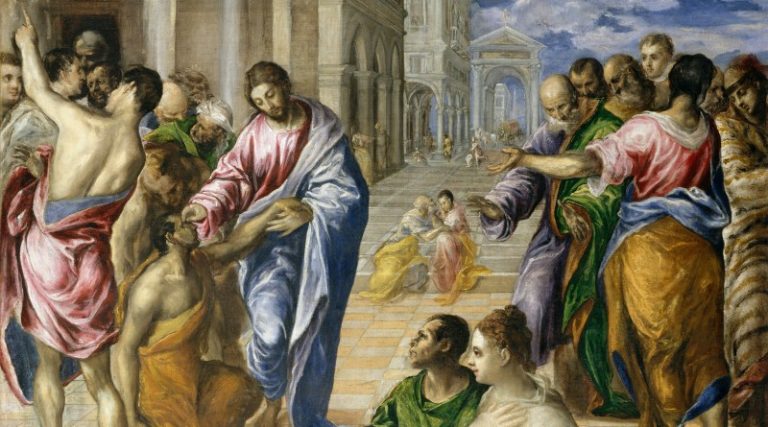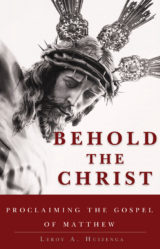By Leroy Huizenga
Leroy A. Huizenga is Administrative Chair of Human and Divine Sciences at the University of Mary in Bismarck, ND. He is the author of Behold the Christ: Proclaiming the Gospel of Matthew.

The Gospel of Matthew presents itself as a universal, authoritative document persisting for all time for the Church enduring for all time through its narrative, through the form of a story. Reading the Gospel of Matthew, then, requires significant attention to its narrative dynamics. Redaction criticism—comparing passages in the Gospel of Matthew with similar or near-identical passages in the Gospels of Mark and Luke apart from their narrative contexts in the Gospels in an attempt to get at what the Gospel writers thought—fails to take account of the storyline of each of the Gospels and ironically goes beyond and behind a Gospel writer’s intention. The evangelists did not intend their Gospels to be read in the way redaction critics peruse, with scrupulous attention to presumed prior sources (in the case of the Gospel of Mark) and utterly hypothetical, not-extant sources (in the case of what scholars call “Q,” a pure reconstruction made from similar passages in Matthew and Luke that supposedly lies behind them). The Gospels draw attention to the Old Testament through the rhetorical devices of allusion and quotation, but they do not quote material from other Gospels directly.
Above all, the Gospels read well as stories, as narratives, for that is what they are; the evangelists composed wholes and intended them to be read as such. Moreover, when one reads the Gospels using redaction criticism, they become surreptitious stories about crises in their anonymous author’s hypothetical communities when they in fact present themselves openly as stories about Jesus. To read as redaction critics do is to read against the grain of the texts. Finally, in canonical perspective, the Gospel of Matthew’s primary position in the fourfold Gospel canon suggests it is to be read before the other three.
For these reasons we should read the Gospel of Matthew as the story it purports to be, and ask what St. Matthew would have an ideal reader make of the story he tells. Human beings are narrative by nature; we’re hardwired to hear and tell stories, to appreciate and interpret them. We tell each other the little tales that make up our lives and sometimes the big story that is our life, and read and watch stories all the time. And so this narrative-approach isn’t some esoteric science but simply a matter of paying attention to the basics we all know from experience and often from school. A story-approach permits the entirety of the text of the Gospel of Matthew to be taken into account (unlike redaction criticism, which focuses on that small percentage of a Gospel’s text that constitutes additions, omissions, and changes) and its narrative dynamics.
When we read the story of the Gospel of Matthew, we find the Gospel pointing not only backward—as it interprets the Old Testament and Judaism through Jesus’s words and deeds—but also forward. Its final words, the Great Commission, wherein Jesus commands his disciples to “make disciples of all nations” (Matt 28:16–20), are not oriented to its own long-lost original community reconstructed through redaction criticism but to the future, to the Church’s time of mission. True, it draws deeply on the past; it is a Gospel of radical continuity with the tradition of the Old Testament and their community of Israel and the later Jews. Yet that continuity is neither repristination nor nostalgia. It draws on that tradition as a resource for mission in the Church’s perpetual present, as the tips of leaves draw on roots.
Above all, the Gospel of Matthew is a story of fulfillment, telling (1) how God has come to earth in Jesus the Christ, the Son of God, to fulfill the promises God made to Israel and the entire human race; (2) how Jesus’s followers can attain true righteousness and salvation; and (3) how Jesus founded a Church to bring God’s promises and sacraments to the ends of the earth.
The Gospel of Matthew tells an ironic story of reversal that is both tragedy and triumph. Ironic because the initial expectations the Gospel raises for us readers are ultimately reversed; tragic, for Israel loses its status as the privileged agent of God’s mission in the world; but also a triumph, in that God’s purposes for the world are not thwarted in spite of the human race’s rejection of Jesus the Christ. Indeed, as the Jesus of Matthew is the embodiment of Israel and the fulfillment of its promises and mission, in Jesus’s vindication at the resurrection and exaltation into heaven Israel herself is vindicated and exalted; Israel’s mission to be a “light to the nations” (Isa 49:6) commences anew as the Church goes into all the world to make “disciples of all nations” (Matt 28:16–20).
You Might Also Like

Behold the Christ: Proclaiming the Gospel of Matthew, by Leroy A. Huizenga, reveals the significance of St. Matthew’s Jesus: He is Emmanuel, God with us always, who saves his people from their sins by dying for them. Keyed to the lectionary and featuring a section on the relevance of St. Matthew’s Gospel for our contemporary age, Behold the Christ will make the Gospel and indeed the Faith real to today’s readers.